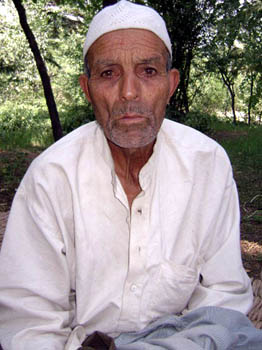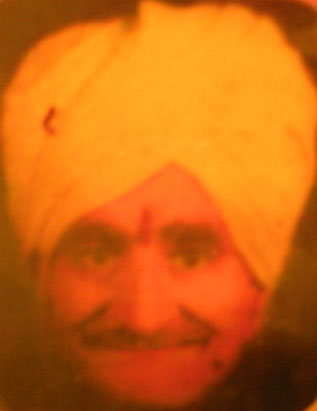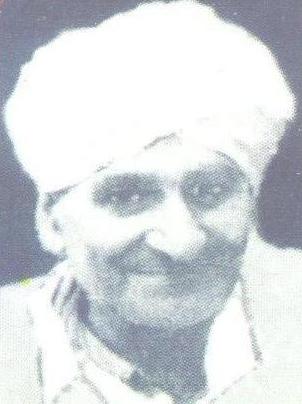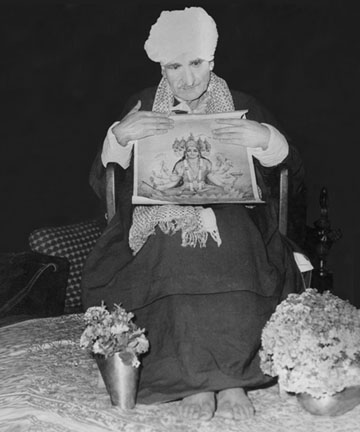Thursday, April 26, 2012
'Hindu Killer
All Standard reference books agree that the name 'Hindu Kush' of the mountain range in Eastern Afghanistan means 'Hindu Slaughter' or 'Hindu Killer'. History also reveals that until 1000 A.D. the area of Hindu Kush was a full part of Hindu cradle. More likely, the mountain range was deliberately named as 'Hindu Slaughter' by the Moslem conquerors, as a lesson to the future generations of Indians. However Indians in general, and Hindus in particular are completely oblivious to this tragic genocide.
Thursday, April 19, 2012
Very Old Photographs Slideshow & Video
Very Old Photographs Slideshow & Video: TripAdvisor™ TripWow ★ Very Old Photographs Slideshow ★ to Jammu. Stunning free travel slideshows on TripAdvisor
Sanits , Sages And Great Personalities of Kashmir (India) Slideshow Slideshow
Sanits , Sages And Great Personalities of Kashmir (India) Slideshow Slideshow: TripAdvisor™ TripWow ★ Sanits , Sages And Great Personalities of Kashmir (India) Slideshow Slideshow ★ to Kashmir. Stunning free travel slideshows on TripAdvisor
Destroyed Hindu Houses And Temples of Kashmir by Militants Slideshow Slideshow
Destroyed Hindu Houses And Temples of Kashmir by Militants Slideshow Slideshow: TripAdvisor™ TripWow ★ Destroyed Hindu Houses And Temples of Kashmir by Militants Slideshow Slideshow ★ to Kashmir. Stunning free travel slideshows on TripAdvisor
Wednesday, April 18, 2012
Martyrs of India Slideshow Slideshow
Martyrs of India Slideshow Slideshow: TripAdvisor™ TripWow ★ Martyrs of India Slideshow Slideshow ★ to Jammu and Kashmir. Stunning free travel slideshows on TripAdvisor
Martyrs of India Slideshow Slideshow
Martyrs of India Slideshow Slideshow: TripAdvisor™ TripWow ★ Martyrs of India Slideshow Slideshow ★ to Jammu and Kashmir. Stunning free travel slideshows on TripAdvisor
Monday, April 16, 2012
Destroyed Hindu Houses And Temples of Kashmir by Militants Slideshow Slideshow
Destroyed Hindu Houses And Temples of Kashmir by Militants Slideshow Slideshow: TripAdvisor™ TripWow ★ Destroyed Hindu Houses And Temples of Kashmir by Militants Slideshow Slideshow ★ to Kashmir. Stunning free travel slideshows on TripAdvisor
Sunday, April 15, 2012
Forgotten Temples of Kashmir Photo series Part-2
|
|
|||
|
Forgotten Temples of Kashmir
Photo series Part-2 An effort to preserve and record Hindu cultural and religios heritage of Kashmir BALA DEVI OF VILLAGE BALHAMA 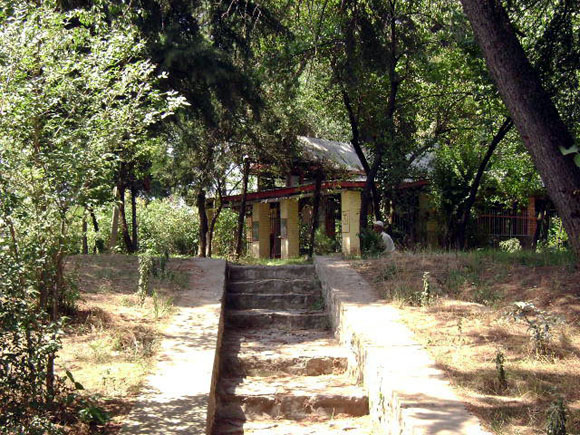 Exclusive images and report from a remote village in Kashmir provided for Shehjar by Chander M. Bhat |
|||
|
Bala
is a Sanskrit word meaning ‘the girl child.’ Worship of Sakti or the
Mother Goddess is a very ancient practice in India. Of the several
aspects of the Divine Mother Parvati, Lalita or Lalita-Tripurasundari is
very important and popular. Bala (also called Bala-Tripurasundari) is
an aspect of this Lalita. Sometimes she is described as the daughter of
Lalita who helped her to destroy the army of the demon Bhandasura.
As her very name suggests, Bala is pictured as an eternal girl of nine years. Iconographical works describe her as red in colour like hibiscus flower. She has four arms carrying sosary, noose, goad and book. Bala is specially worshipped, by those desiring psychic powers.” [A Concise Encyclopedia of Hinduism by Swami Harshananda] The abode of Bala Devi in Kashmir valley is at Village Balhama which is about thirteen kilometers from Srinagar. This village is surrounded by village Wuyan in the east, Khunmoh in the north and Pampore town in the west. This village is about 3 km on the right side near Pantha Chowk, a link road near Pampore Joinery Mill. According to the local folk lore the original abode of Bala Devi is in South India. It is said that the saint of the temple had a dream in which she told him to visit Kashmir where he could have her darshana. The saint along with his devotees as per the divine blessings visited the village of Balahama which was a dense forest at that time. The goddess gave darshana to the saint in a spring. In order to keep the sanctity of the shrine she directed him to plant five saplings of Devdar trees around the spring which in the course of time grew to full size Devdars. The five Devdar trees are believed to be more than five thousand years old and is the principle object of veneration. The spring in later years faded away under the trunk/girth of Deodars.
Thirty Kanals of land is attached to Bala Devi temple and the temple has been built in the right side of the plot/land facing towards east. There is a small hut having only one room which is believed to be the residence of the Chowkidar. The temple has been built by constructing a circular brick pillars covering the five Devdar trees and thereby joining the pillars by steel fencing. At present there are five Hindu families who are looking after the temple. A local namely Gh. Qadir has been engaged as the Chowkidar by the local Pandits on Rs. 600/- as monthly remuneration. At present the temple is having a deserted look due to lack of maintenance and proper care due to forced migration of Pandit families from this village. |
|||
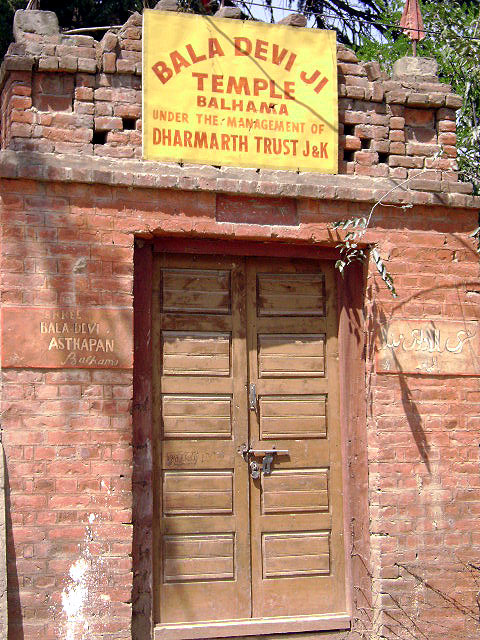 Main entrance of the temple |
|||
|
Icons near the gate |
|||
 Inner View of the hall |
|||
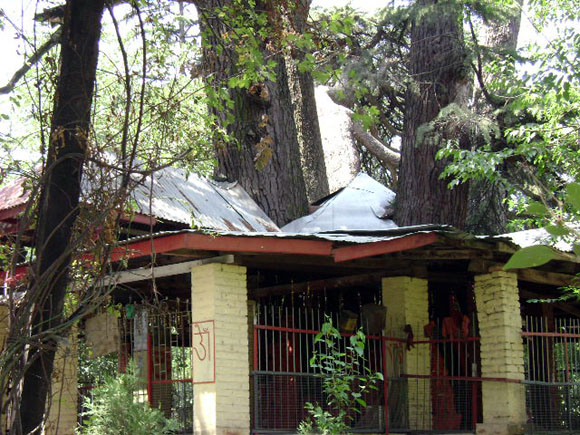 Five deodar Trees inside the temple |
|||
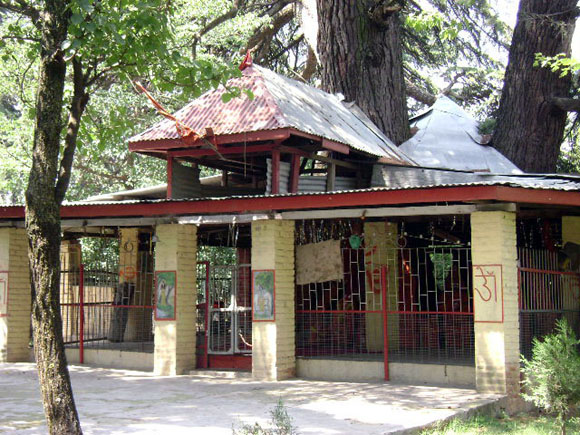 Deserted Temple Building |
|||
|
Icons of faith now unattended |
|||
|
|
|||
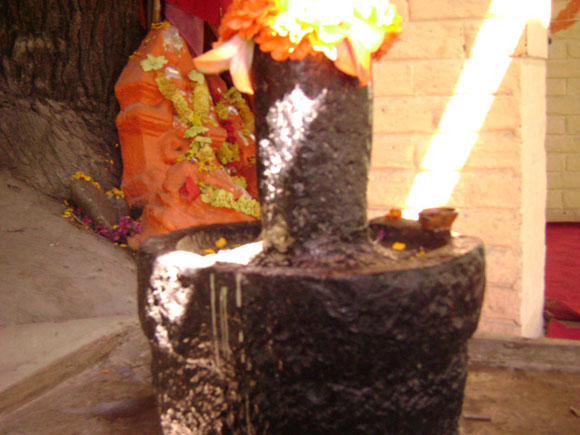 Shiv Lingam inside temple |
|||
 Top of the Deodar which was once source of cool shade for Kashmiri hindus |
|||
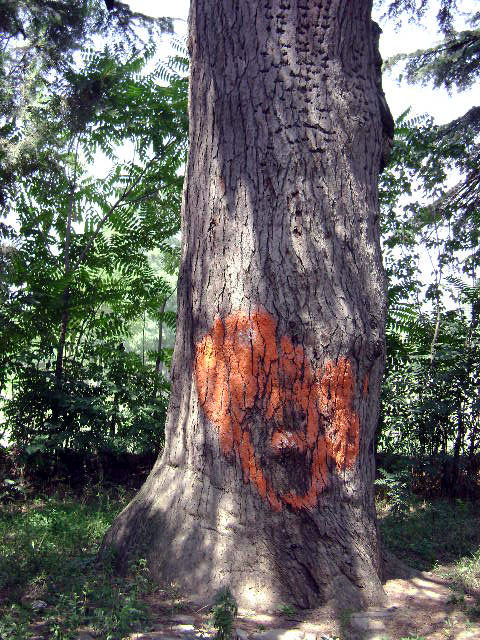 A big Deodar at the Southwest corner of the temple |
|||
|
|
|||
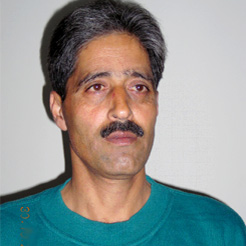 *Born
on 20th March, 1960 in Murran a village in North Kashmir, Chander M.
Bhat is presently working as an Assistant Supdt. Posts, in Department of
Posts, Govt. of India. His articles regarding Posts and of
non-political nature stand widely published in various papers and
magazines of the country. A booklet “How to Collect Stamps” published by
the Department of Posts, has earned him genuine accolades. He worked on
the project of tracing the roots of his co-villagers and of the village
Murran, resulting into the culmination of a widely acclaimed book
“Murran …My Village”. Man with depth, Chander M. Bhat has also another
book, “Ocean by Drops” (collection of poems) in his vase having colorful
poems. His book “Ancient History of Jammu and Kashmir”, confirms his
researching capability. Various research papers like “The Splendor that
is Amarnath” and “Vitasta…The Sacred River of Kashmir” are valuable
additions to his works that has proved very fruitful and guiding force
in the exile period of Kashmiri Pandits community of which the author is
also a member. *Born
on 20th March, 1960 in Murran a village in North Kashmir, Chander M.
Bhat is presently working as an Assistant Supdt. Posts, in Department of
Posts, Govt. of India. His articles regarding Posts and of
non-political nature stand widely published in various papers and
magazines of the country. A booklet “How to Collect Stamps” published by
the Department of Posts, has earned him genuine accolades. He worked on
the project of tracing the roots of his co-villagers and of the village
Murran, resulting into the culmination of a widely acclaimed book
“Murran …My Village”. Man with depth, Chander M. Bhat has also another
book, “Ocean by Drops” (collection of poems) in his vase having colorful
poems. His book “Ancient History of Jammu and Kashmir”, confirms his
researching capability. Various research papers like “The Splendor that
is Amarnath” and “Vitasta…The Sacred River of Kashmir” are valuable
additions to his works that has proved very fruitful and guiding force
in the exile period of Kashmiri Pandits community of which the author is
also a member.Presently the author is working on “OOL…THE NEST” a six volume project on all the 595 [each volume of about 2500 pages] Kashmiri Pandit villages of Kashmir. | |||
Forgotten Temples of Kashmir
|
|
||||||||
|
Forgotten Temples of Kashmir
Photo series Part-1 An effort to preserve and record Hindu cultural and religious heritage of Kashmir SAIKH RAZA…..OF VILLAGE WANPORA [NAHAMA]  Exclusive images and report from a remote village in Kashmir provided for shehjar by Chander M. Bhat |
||||||||
| Wanpora popularly known as Thanther Wanpor is
a small village in Pulwama District. This village forms the boundary
between Pulwama and Badgam District on the West side. Kashmiri Pandits
were also residing in the village up to 1990. Saikh Raza was the village
diety of the Kashmiri Pandit families. No Pandit family is presently
residing in this village. This village is famous for Thanther [blacksmith], a class who were making loya thaal, khias, Kanzi Khias, dul, gada, thoor etc for Kashmiri Pandits. Wanporek Thanther was very famous throughout the valley. Before 1990 one could hear the beating of louy from the shops situated on the bank of a small stream coming down from Saikh Raza temple. This temple is situated in the north-west of the village at an isolated place surrounded by paddy fields and dense trees. A small stream is also flowing in front of this temple having muddy water [Gurei Woan in Kashmiri]. It remains muddy throughout the year. Sh. Ajay Pandita of village Lajura [Pulwama], who is still residing in his native village along with his family, accompanied me to this temple. It was 8th August 2009 at about 3 p.m. After reaching the temple we started cutting the wild shrubs grown inside the burnt temple, collected idols, which were scattered in the premises of the temple, arranged them near the trunk of the Banyan Tree [Bren in Kashmiri], applied sandoor, fixed three red jindis on the bran tree, lighted doop etc and went to capture. About 18 village children were watching our actions with rapt attention. It was learnt that some miscreants set the temple on fire in October 1990. However the land of the temple has not been encroached till date. It has become a barren land now. |
||||||||
 Baniyan tree [Bren in Kashmiri] was burnt in the year 1990 |
||||||||
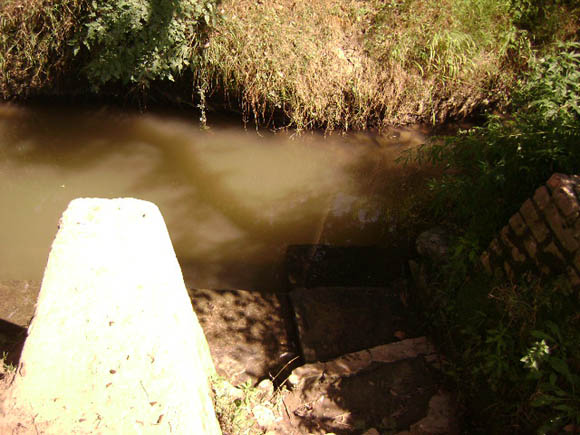 A small stream flowing in from of the temple have muddy water [Gur Poein in Kashmiri] |
||||||||
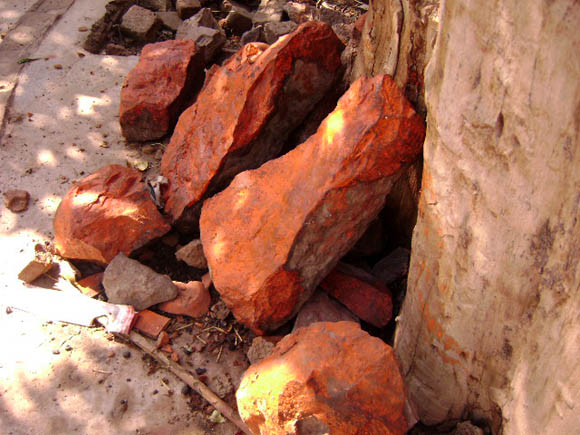 Mutilated idols |
||||||||
 A Close up of the main temple |
||||||||
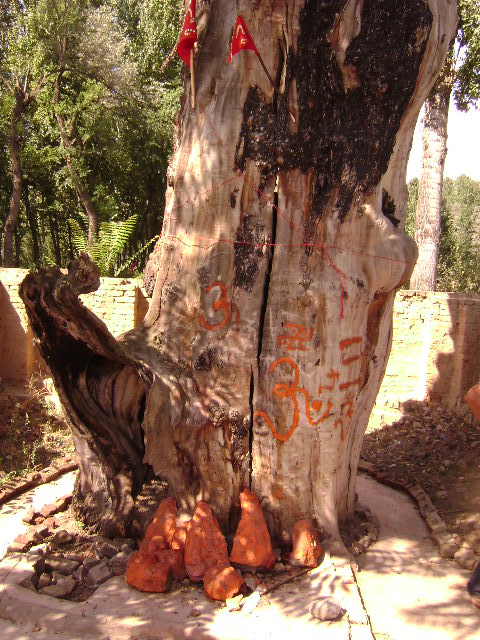 A Close view of the sacred Banyan tree |
||||||||
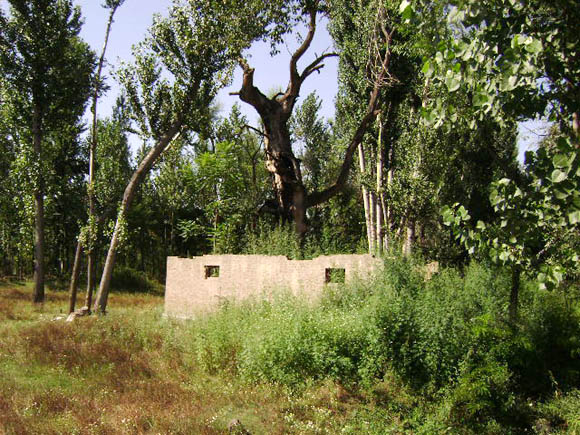 A view of the room built for storing temple belongings |
||||||||
 Inside the store room |
||||||||
 Main temple |
||||||||
 Scenic beauty tells the tale of its existence when Kashmiri Hindus were in the village |
||||||||
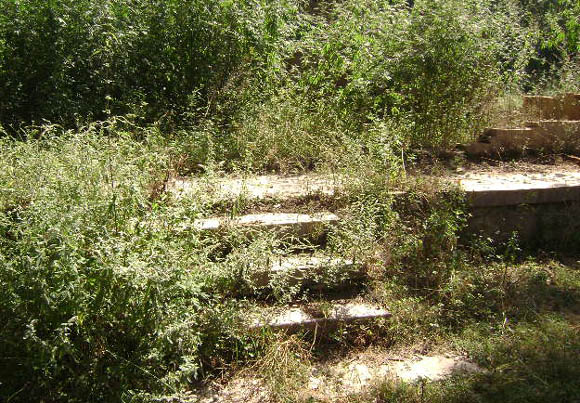 Steps to the main entrance |
||||||||
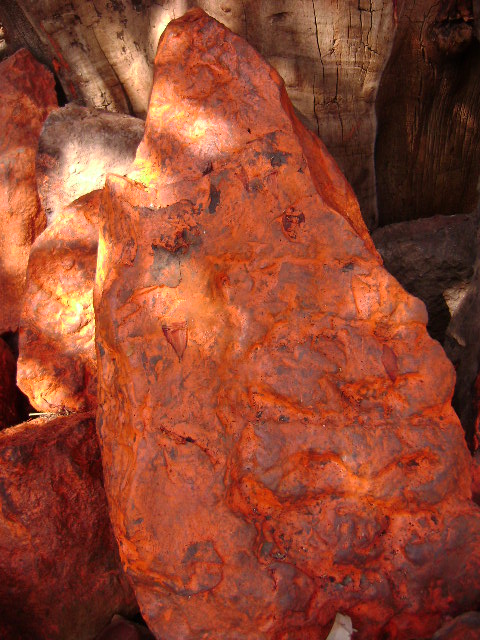 Symbols of faith were scatterd in the premises of the temple |
||||||||
 The lost Bren...all errect with the hope of good days for Pandits |
||||||||
|
|
||||||||
 *Born
on 20th March, 1960 in Murran a village in North Kashmir, Chander M.
Bhat is presently working as an Assistant Supdt. Posts, in Department of
Posts, Govt. of India. His articles regarding Posts and of
non-political nature stand widely published in various papers and
magazines of the country. A booklet “How to Collect Stamps” published by
the Department of Posts, has earned him genuine accolades. He worked on
the project of tracing the roots of his co-villagers and of the village
Murran, resulting into the culmination of a widely acclaimed book
“Murran …My Village”. Man with depth, Chander M. Bhat has also another
book, “Ocean by Drops” (collection of poems) in his vase having colorful
poems. His book “Ancient History of Jammu and Kashmir”, confirms his
researching capability. Various research papers like “The Splendor that
is Amarnath” and “Vitasta…The Sacred River of Kashmir” are valuable
additions to his works that has proved very fruitful and guiding force
in the exile period of Kashmiri Pandits community of which the author is
also a member. *Born
on 20th March, 1960 in Murran a village in North Kashmir, Chander M.
Bhat is presently working as an Assistant Supdt. Posts, in Department of
Posts, Govt. of India. His articles regarding Posts and of
non-political nature stand widely published in various papers and
magazines of the country. A booklet “How to Collect Stamps” published by
the Department of Posts, has earned him genuine accolades. He worked on
the project of tracing the roots of his co-villagers and of the village
Murran, resulting into the culmination of a widely acclaimed book
“Murran …My Village”. Man with depth, Chander M. Bhat has also another
book, “Ocean by Drops” (collection of poems) in his vase having colorful
poems. His book “Ancient History of Jammu and Kashmir”, confirms his
researching capability. Various research papers like “The Splendor that
is Amarnath” and “Vitasta…The Sacred River of Kashmir” are valuable
additions to his works that has proved very fruitful and guiding force
in the exile period of Kashmiri Pandits community of which the author is
also a member.Presently the author is working on “OOL…THE NEST” a six volume project on all the 595 [each volume of about 2500 pages] Kashmiri Pandit villages of Kashmir. |
||||||||
|
|
||||||||
| Copyrights © 2007 Shehjar online and KashmirGroup.com.
Any content, including but not limited to text, software, music, sound,
photographs, video, graphics or other material contained may not be
modified, copied, reproduced, republished, uploaded, posted, or
distributed in any form or context without written permission. Terms & Conditions. The views expressed are solely the author's and not necessarily the views of Shehjar or its owners. Content and posts from such authors are provided "AS IS", with no warranties, and confer no rights. The material and information provided iare for general information only and should not, in any respect, be relied on as professional advice. Neither Shehjar.kashmirgroup.com nor kashmirgroup.com represent or endorse the accuracy or reliability of any advice, opinion, statement, or other information displayed, uploaded, or distributed through the Service by any user, information provider or any other person or entity. You acknowledge that any reliance upon any such opinion, advice, statement, memorandum, or information shall be at your sole risk |
Holiest of Holy Shrine
Chander
M. Bhat
Born on 20th
March, 1960 in Murran a village in North
Kashmir, Chander M. Bhat is presently working as
an Assistant Supdt. Posts, in Department of
Posts, Govt. of India. His articles regarding
Posts and of non-political nature stand widely
published in various papers and magazines of the
country. A booklet "How to Collect Stamps"
published by the Department of Posts, has earned
him genuine accolades. He worked on the project
of tracing the roots of his co-villagers and of
the village Murran, resulting into the
culmination of a widely acclaimed book "Murran
…My Village". Man with depth, Chander M. Bhat
has also another book, "Ocean by Drops"
(collection of poems) in his vase having
colorful poems. His book "Ancient History of
Jammu and Kashmir", confirms his researching capability. Various research papers like
"The Splendor that is Amarnath" and "Vitasta…The
Sacred River of Kashmir" are valuable additions
to his works that has proved very fruitful and
guiding force in the exile period of Kashmiri Pandits community of which the author is also a
member.
________________________________________________________________________
Kashmir valley is traditionally divided into two parts Maraz and Kamraz. Maraz was southern part of Kashmir while as Kamraz comprised northern part of Kashmir. Srinagar was central point of both the divisions. Anantnag was the Headquarter of Maraz division while as Baramulla was the seat of attraction for Kamraz division.
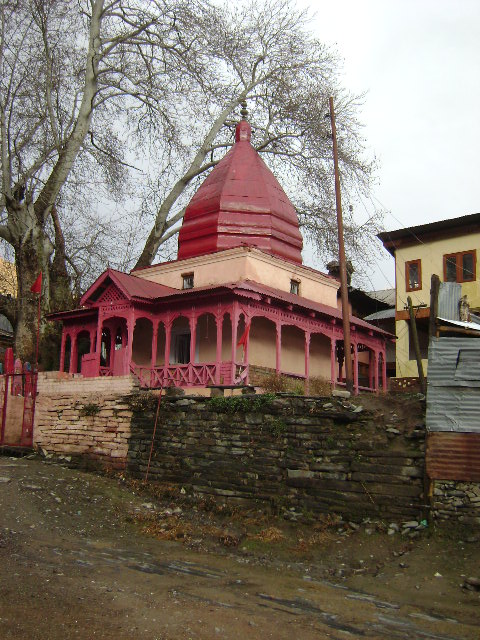
Main Temple
Baramulla has its origin to the era of Kashyapa Rishi. The water of Satisar was
drainaged from a place through a deep valley between two hills at Sheeri Narvaw
resembling the mouth of Varah, The Boar. This Varah Moh changed its
identity as Varmul and started to be called as Varamulla.
Varamulla is the entrance point to the valley through Muzzafarabad Uri Road and
is 55 km away from Srinagar. There is another story as to how Baramulla came to
be known as Varahmul. There was a shrine of Lord Vishnu and was called Adi
Varaha. The shrine was located on Eastern bank of Vitasta near Kotitirth. The
name Varamulla is also probably related to the shrine place of Adi Varah, the
Boar. It is held in great esteem since ancient times and has repeatedly
mentioned by Kalhan Pandit in Rajtarangni. The temple was vandalized by Afghan
ruler Sikander Buthshikan. The ancient Shiv Linga and some stone images in
Kotitirth is said to be belonging to the shrine of Adi Varah at the same bank of
Vitasta.
The town of Baramulla faced the ire of tribal invaders in 1947 and a large scale
damage was done to Hindu and Sikh fraternity falling into their hands. Sh.
Jawahar Lal Nehru wanted to rename Baramulla as Maqboolabad to commemorate the
martyrdom of the nationalist Sherwani. However Baramulla retained its identity.
On
the left bank, close to Baramulla, is the ancient site of Hushkapur
(present Ushkur). Hushka had built a vihara, a stupa and a Vishnu Temple. As per
local tradition, Heun Tsang, on arrival in the Valley, stayed here for the first
night. Later, he said that some copper plates, on which the proceedings of
Kanishka’s council were engraved, lay buried here.
The importance of this shrine is described in Kotitirthamahatmya [part of
Bhringisha Samhita]. Presently, the shrine is known for the Shiva temple,
inside the sanctum sanctorum of which stands a unique five feet Shivlinga with a
face. The shrine has a dharamshala and a holy spring. The water of the
holy spring is cold in summer and hot in winter. At present dharamshala
is occupied by CRPF and its maintenance is being done by them.
Right above this temple there is another temple which is called Ganganor.
Ganganor is a holy spring at Mohalla Rajghat. A small temple has been built
on this sacred spring. It is said that the spring receives water from seven
springs existing above at an elevation on the small hillock called Gousain
Teng. There are seven springs on Gousain Teng with a temple. Each spring has
its name viz. Ram Kund, Sita Kund, Laxhman Kund etc. Simultaneously, water from
all the springs with independent out lets combine to form a brook and passing
into a phase of journey. It is believed that it belongs to the Lord Rama’s
period.
There was a number of Kashmiri Pandits living in Baramulla. After invasion of
tribal invaders, many Kashmiri Pandits of Baramulla choose to migrate to other
parts of the country and many more were killed by tribal invaders. Before
migration some 536 Kashmiri Pandit families were living in Baramulla and had
their households scattered in Rajghat, Dewan Bagh, Khowja Bagh, Kanlibagh, Jetty
Road and Ramghat. After mass exodus only one Kashmiri Pandit namely Sh. Mohan
Lal stayed back braving all odds. Some Kashmiri Pandits families from Jammu have
returned back and are staying in a temple. They are doing small trades in
Baramulla now. Two families staying at Khowja Bagh did not migrate and are still
residing there.
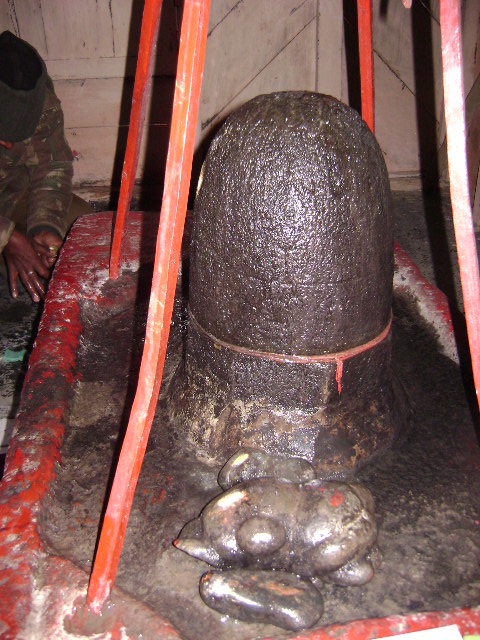
Shiv Lingam inside small Shiv Mandir near Kotitirth
The shrine topography described above remains incomplete without getting mention
of Ram Mandir of Ramghat. A Janki was always taken from this temple on
occasions of Ram Navmi and Dussehra. Another temple near Kotitirth is the temple
of Bhairav known as Bhairav sund [Bharaiv Bagh]. Shushnoor was offered on
dates of festivals specializing the occasions in the honour of the deity.
Near Kotitirth there was a ghat on river Vitasta called Kotighat. This place was
used for the purpose of 10th day Kriya of the departed souls. The
ashes of the dead were immersed in Vitasta at Kotighat. Adjacent to Kotighat is
cremation ground comprising of five kanals of land.
All these things are there but the people whose presence once thrived on the
face of Varamul are now few and far between.
References
Place Names in Kashmir by
B.K. Raina and S.L. Sadhu
published by Bharatiya Vidya Bhavan, Mumbai and Indira
Gandhi National Centre for the Arts, New Delhi
Image Gallery:
http://ikashmir.net/gallery/categories.php?cat_id=234
Posted by : Vipul Koul , Edited by : Ashok Koul
(THE ABOVE ARTICLE IS WRITTEN BY SH CHANDER M BHAT )
Saturday, April 14, 2012
Sed Bab
|
Friday, April 13, 2012
Human Rights Violations of Kashmiri Hindus
Human Rights Violations of Kashmiri Hindus
 An Appeal
An AppealINTRODUCTION
This is an appeal by the intellectuals of a small yet distinct ethno-religious community, the Kashmiri Pandits (Hindus) who have a history of more than five thousand years of a rich cultural tradition and a unique religious philosophy of the universality of man, peace and amity amongst peoples. Down the ages, this aboriginal community of the valley of Kashmir has readily opened itself to foreigners of all faiths, creeds and professions who came as travellers and settlers. However, it has repeatedly been the tragic victim of religious persecution, forcible conversion, violence and brutal massacre at the hands of invading muslim zealots and religious fanatics leading to repeated exodus of the community, rendering it a minority in its own land.
This appeal gives a brief outline of the barbarities that the community faced at the hands of the despotic muslim rulers since the heydays of Islamic fundamentalism, as it made inroads into Kashmir after the 13th century. It traces the present escalation of human rights violations amounting to genocide of this community to a cruel and criminal conspiracy by the fanatical and fundamentalist forces which gained ascendency and got fresh impetus during the last four decades. It also provides a bird’s eye-view of the sprouting of dormant forces of Islamic Fundamentalism during these years in the religious schools that mushroomed in the valley and became nurseries for the growth of religious hatred, militancy and terrorism. This indoctrination prompted and incited young cadres to cross over to Pakistan and Pakistan-held Kashmir so as to receive arms training and carry out the diabolical plan for the muslimization of Kashmir as a prelude to its secession from secular democratic India. The hounding out of more than three hundred thousand Kashmiri Pandits (Hindus) from the valley from 1989 onwards was the first phase of this sinister operation.
This appeal brings out in vivid detail persecution of the minority community followed by threats, abductions, extortions, tortures and killing by brutal means of its members from all walks of life which led to exodus. A virulent disinformation campaign was started before the mass exodus against this community and followed up with fanatical zeal, after the exodus, in order to secure total ruination of the community. The present plight of the community, once given to academic, philosophical and spiritual pursuits, and now rootless and without identity, is given in some detail. Over one thousand members of the community have been killed by the terrorists and the thousands are dying in the miserable camps for want of basic amenities, shelter, medicare and family support; and thousands of its youth are getting scattered in search of livelihood. It is feared that at the present rate of dispersal the community is disintegrating beyond redemption and facing total extinction.
This appeal invokes the conscience and compassion of the civilized world to grasp the grim tragedy facing the Kashmiri Pandit community and to stand up and speak for it and help it regain its lost status and get rehabilitated once again, with honor and dignity in its own homeland.
APPEAL
The armed subversion by Muslim fundamentalist/terrorist youth to destroy the pluralistic, secular socio-political character of Kashmir valley and reduce it to a reactionary, monolithic, theocratic one, has entered its fourteenth year of operation. The grand design of this separatist insurgency is aimed at snapping all historical, economic, cultural, and political links of Kashmir valley with India and annexing it with Pakistan which is encouraging it overtly and covertly and lending moral, financial, political, diplomatic and military support. The first objective of this diabolical plan i.e. hounding out the Kashmiri Pandit (Hindu) ethnic minority from the Kashmir valley is being pursued with fanatic zeal.
PRIME TARGETS
The Kashmiri Pandits (Hindus) in the valley of Kashmir, irrespective of their age, sex, position status or situation became the prime target of the terrorists’ onslaught. They were warned and threatened, individually and collectively, through word of mouth, through insinuation and innuendo, through posters and press and over loud speakers installed in thousands of mosques all over the valley. Fear loomed large and the terrorist shadow stalked educational markets and other public places wherever the Kashmiri Pandits had a representation, however small. They were identified and denounced; hit lists were exhibited on electric poles, office doors and entries to numerous institutions; and the public at large was exhorted to watch them and hound them out. They were followed and kidnapped from their homes and places of work and interrogated and tortured. A spree of killings of the intellectuals of the community started. This was followed by indiscriminate gunning down, hanging, dismembering, tying with grenades and blasting into pieces, skinning, burning and sawing alive the members of this ethnic minority of all walks of life. Many of the victims after being butchered were thrown into streets as exhibits for everybody to get terrorised. The bereaved were not permitted to mourn the dead and perform the last rites. Those who dared to attend the funeral were earmarked for reprisals. Molestation and rape was the order of the day.
The gamut of the terrorists’ depredations puts the notorious programs in shade and leaves nobody in doubt about the design of the terrorists to exterminate Kashmiri Pandits (Hindus) who started fleeing temporarily out of the valley to seek shelter in the Jammu province of the State of Jammu and Kashmir, in Delhi and in other towns of India during the months of January-March 1990. A large number preferred to stay behind, partly hopeful of a let up in the persecution and the frantic killings and partly on account of the reassurances by their friends, neighbours and colleagues of the muslim majority community. However, indiscriminate murders gained momentum as also the tauntings, ridicule, accusations, denigrations and warnings issued to the Pandits (Hindus ). Those who dared to return to the valley even after a brief absence were frisked and taken for questioning and accused of having spied against the terrorists and of having received arms training to counter the terrorism. They were followed like a shadow or given a time limit of a few hours or a day to quit the Valley.
INTIMIDATORY WARNINGS
Not content with the tempo of exodus of the ethnic minority community, the Muslim religious zealots pressed into service the local daily newspapers and started periodic write ups in a vituperative and malicious propaganda offensive against the Kashmiri Hindius, culminating in repeated warnings and final ultimatum through the pages of “Daily Alsafa” on l4th April,1990 giving the community two days to leave the valley or face retribution and death. The good Samaritans of the Muslim majority community who had offered help, solace and protection to the Kashmiri Pandits were also threatened, coerced and subdued to fall in line with the fundamentalist designs and they, therefore, advised the Kashmiri Pandits to leave the valley for a ‘temporary period’ till normalcy returned to the valley. Both gentle and well meaning persuation was adopted side by side with covert and overt threats to recalcitrant Hindus forcing them into exodus. Meanwhile unbridled violence and brutal murders went on . More than one thousand Hindus have been killed, hundreds are missing, possibly dead or kept hostage. Women have been held captive in remote hideouts of the terrorists to satisfy their lust . An unspecified number of those Hindus who are still livlng in the valley in mortal terror are victims af extortion, religious persecution and kidnappings.
CANARDS GALORE
This communal carnage and forced exodus was followed up with a virulent compaign of vilification and disinformation against the Kashmiri Hindu community with the twin objective of covering up the true communal-fundamentalistic character of the so-called freedom struggle of the terrorists and securing total ruination and annihilation of this ethno-religious minority. This propaganda offensive was backed up by canards floated across the length and breadth of the country that:
i) the Kashmiri Pandits migrated out of the valley because they were touted by Mr. Jagmohan, the then Governor of Jammu and Kashmir, who promised them relief, ration and land. That those who were gunned down, hanged or tortured were informers and enemies of the “freedom struggle”. This canard took such deep roots inside and outside the valley that the poorly informed public even of cosmopolitan cities like Delhi and Bombay who go by the common knowledge that in India Hindus are in majority and by corollary the majority in Kashmir valley are Hindus, failed to understand why Kashmiri Hindus had to flee their homes and hearths. Only the committed demographers in the country realise that Kashmiri Pandits (Hindus) are a minority in the muslim rrajority Kashmir valley of a Hindu maiority India.
ii) the Kasnmiri Pandits are over-represented in Central and State Government Services and private Jobs and that this was a major source of irritation with the disenchanted muslim youth, who out of frustration took to arms to fight for their justful rights. This canard has been supplemented and reinforced by distorted statistics and the thread has been skillfully taken over by some self-proclaimed humanists and over-zealous politicians of the country who want to prove more secular than their credentials allow. Infact they found it a useful tool to convince themselves and the world that terrorism in Kashmir was not an armed subversion aimed at the secession of the State from the union of India but an act of frustration of a handful of “disgruntled and misguided youth”. This ill conceived notion though countered by the exiled Kashmiri Pandits, fell on deaf ears and did not get the attention of the media which were only vying with each other to score points for the terrorists and their cause. It did not take long for the communal, fundamentalistic and subversive character of terrorism to emerge in its true colour.
iii) the Kashmiri Hindus because of their merit, cunning and influence would become usurpers and take over educational institutions, professional colleges, trade, industry, Government jobs etc. in Jammu, Delhi and other places where they have taken refuge. This disinformation caused tremendous confusion, panic, over-reaction and even hostility in the host towns which were ill equipped to accommodate such a sizeable- influx of refugees, especially in Jammu where seventeen camps have been set up in the suburban dingy areas, Stiff resistance was put up even for admission to the exiled students in various educational institutions; jobs were denied to the youth and all doors were closed for the rehabilitation of professional and non professional personnel of the community. A community which prided itself in its academic excellence and high professionalism is idling and rotting, for the last six years.
While torture, persecution and killing were going full steam side by side with the canards floated against the fleeing community, the marauding terrorists started loot, plunder and arson of the properties and estates left behind by Hindus. They desecrated and destroyed their temples, confiscated their stores and stocks, stole their kind, harvested their crops and encroached upon and annexed their lands. Till date more than three thousand Hindu houses have been blasted or razed to ground. The remaining have been looted, vandalized or occupied.
COLOSSAL TRAGEDY
Within months of the exodus of Kashmiri Pandits the Government, whether out of misplaced optimism to placate and appease the terrorists or with deliberate intent, started recruiting and promoting Muslims to the posts and positions vacated by the Kashmiri Pandits. This has boosted the sinister designs of the terrorists to discourage and thwart the minority Kashmiri Pandit community to return to the valley for it has neither the jobs for livelihood nor the houses for shelter left behind.
So a tragedy which began with religious persecution and genocide, climaxing with the exodus of the community, has now attained colossal dimensions . This ethno-religious minority is presently going through a grim battle for survival and facing the torment of a bleak and uncertain future. Having been forced to live under torn and tattered tents, in ramshackle camps or in one room tenements and stables vacated by cows and buffaloes and rented at exorbitant prices, they are subject to the vagaries of a harsh climate, a hostile populace and an indifferent and callous administration. They have to go through a tortuous procedure to establish their credentials as exiles to be entitled to a meagre relief and measly rations for which they have to queue up for long hours and face untold miseries and humiliation to satisfy the whims and moods of relief commissioners and their minions. They have become the victims of bureaucratic bungling and corruption. They are pawns in the hands of political parties and power brokers. They are being pushed around and harassed for demanding their justful rights; and kicked, cane-charged and arrested for raising their voice against a deaf administration. Thus they have been reduced to abject poverty and a state of utter helplessness and apathy. Their greatest tragedy is that they have become exiles in their own land, aliens in their own country which they inhabited for thousands of years.
The community is now caught in a piquant and unsavory situation as the State and the Central Governments are treating it as expendable. The authorities are hushing up the genocide, the exodus and the present plight of the Kashmiri Pandit community which have resulted as much out of the total abdication of their authority and responsibility, as out of the religious crusade of the terrorists. Nor is the international community aware of the refugee status of this community as countries around the world recognize refugees only when they are forced to flee into another country.
NAKED VIOLATION
The last two years (Editor’s note: currently five years as this appeal is three years old) have witnessed a perpetuation of human rights’ violation against this community which had to leave the valley helter-skelter and got dispersed far and wide in different parts of the country. Most of the nearly three hundred thousand refugees came out with clothes barely enough to cover their bodies. They came out with the illusion of a return to their homes and hearths in the near future. Families got split and scattered in the scramble for shelter and livelihood. Parents got separated from children, spouses from their partners, brothers from sisters. They are still on the move from one place to another like wandering nomads looking for help and succour. As a result of this dispersal the social fabric of the community is torn asunder, the economic structure has collapsed, material possessions have vanished and the political base has been overturned. The old and infirm of the community have met a premature end, dying for want of health and family support. A large number of youth suffered mental breakdown. Depression, panic attacks, phobias, nightmares and insomnia have seized all age groups. Unnatural deaths in the form of sunstroke, snake and scorpion bites, hydrophobia and accidents have taken a big toll. The terror, a feeling of siege, a sense of rootlessness and loss of identity, the trauma of forced migration, exposure to an alien and hostile environment, problem of acclimatization, poor housing, insanitary conditions, lack of basic amenities like drinking water, scarce medicare, malnutrition and idleness compounded by hurt and humiliation have orchestrated to result in physical, mental and psychological trauma of unimaginable magnitude. The community has reached the end of the tether and its reserves of patience and hopes have dried up. The spectre of disease, death and extinction are haunting the community. It seems unlikely that the community will ever be able to organise itself again into a cohesive social and political entity which is vital for its survival and resurgence. Far from regaining its pristine glory, it is hard pressed to keep body, mind and soul together.
It is indeed deplorable that some human rights’ organisations reporting on the Kashmir situation have conveniently ignored the gross human rights violations against Kashmiri Pandits. Their silence on the genocide of this community and the terrible plight facing the community after the exodus, is intriguing and exasperating and puts the credibility of these organisations into shade. The one-sided, partisan and extremely prejudicial views of certain agencies that have chosen to black-out the brutalities and murderous killings of Kashmiri Pandit minority in their reports, leads one to believe that such organisations have fallen victims to the dangerous ploy of the terrorists and become tools in their propaganda machinery against this community and against India.
It is a sad commentary on the perceptions and sensitivities of the civilized world that a community which has been the original inhabitant of the valley of Kashmir with a chequered history of more than five thousand years, a rich cultural heritage and a distinct ethno religious identity, the proponent of and heir to a unique concept and creed of Hindu thought – the philosophy of Kashmir shaivism with its message of Universality of man, peace, non-violence, amity and brotherhood – is being deliberately and systematically destroyed.
History is replete with the records of religious persecutions and barbarities perpetrated against this community since the advent of Islam in the thirteenth century in Kashmir. While the community accommodated, mingled with and absorbed the culture and traditions of all outsiders who came to Kashmir, it was repeatedly rewarded with the most inhuman and brutal treatment. From time to time various cruel Muslim rulers driven by religious zeal and communal frenzy demolished Hindu institutions and shrines, burnt religious scriptures and libraries of Hindus and unleashed a reign of terror leading to the imposition of heavy taxes, forcible conversions and general massacre of those refusing to embrace Islam. They inflicted bestialities like the chopping off of the noses and tongues, beheading, drowning in water after tying people back to back etc. on the community. Those who escaped forcible conversion, mutilation and death were forced into exile reducing this community to a minority in its own land.
SUSTAINED CONSPIRACY
Even after attainment of independence and accession of Jammu and Kashmir to India the fundamentalist forces in the Kashmir valley refused to accept the principles of secularism and democratic pluralism and intensified their nefarious designs against the minority community of Kashmiri Hindus and against the Indian Republic. Under a macabre programme, ‘makatabs’ (Religious schools) were established in every nook and corner of the Kashmir valley with the putative aim of teaching religious scriptures to youth but with the real intent of indoctrinating and envenoming these impressionable minds with anti-Hindu and anti-India hatred. Funds were lavished on these school s openly and clandestinely by local patrons as well as Muslim countries espousing Islamic fundamentalism round the world led by Pakistan, and the schools became nurseries for the growth of fundamentalism and terrorism. A ban imposed by the Government of Sheikh Mohd. Abdullah on these schools in 1977 was lifted soon after its imposition under relentless pressure by Jamat-i-Islami and other fundamentalist organisations.
These pressure groups gradually extended their tentacles in every sphere of administration, bureaucracy and judiciary in the State and molded these institutions in a cruel conspiracy against Kashmiri Pandits resulting in discrimination, alienation, denial and deprivation of this community over the years. The process of Islamisation and fundamentalism which started in 1947 took firm roots by 1986 when the fundamentalist/terrorists enacted a dress rehearsal of the present terrorism on a small scale by arson, loot and plunder of Kashmiri Pandit property and their temples in the Anantnag district of the Kashmir valley. No serious effort was made by the administration to bring the guilty to book. This encouraged them to cross the border to attend arms training camps in Pakistan over the next three years during which they brought with them large quantities of sophisticated arms and ammunition to carry on full scale subversion and terrorism. The cataclysmic events leading to genocide and mass exodus of the Kashmiri Pandit community from 1990 onwards is the culmination of this long process of regimentation, indoctrination, religious frenzy and terrorism.
APPEAL TO WORLD CONSCIENCE
It is high time that the conscience of mankind awakens to the reality of the situation in Kashmir where the so-called freedom struggle is merely an extension and escalation of the ongoing offensive against a small yet ancient and distinct ethno-religious community which has been turned into a minority – the Kashmiri Pandit (Hindu) – who is being exterminated under a diabolical plan masterminded by religious zealots turned terrorists with the direction, support and connivance of their mentors from across the border in Pakistan.
We appeal, therefore,
to all the nations of the world;
to all peace loving, secular and democratic countries which value and recognise the urges, aspirations and just rights of minorities round the globe;
to all organisations that monitor and report on human rights’ violations against ethnic religious communities; and
to all individuals, groups and institutions that stand for justice, equality, religious tolerance and human dignity to break their silence and speak out and save this ancient and distinct ethnic-religious minority of the world which has been thrown out of its own land, made a refugee in its own country and which is, now, facing dispersal, disintegration and extinction.
Source : PanunKashmir.org
Posted by: Vipul Koul
Edited by : Ashok Koul
Subscribe to:
Posts (Atom)

